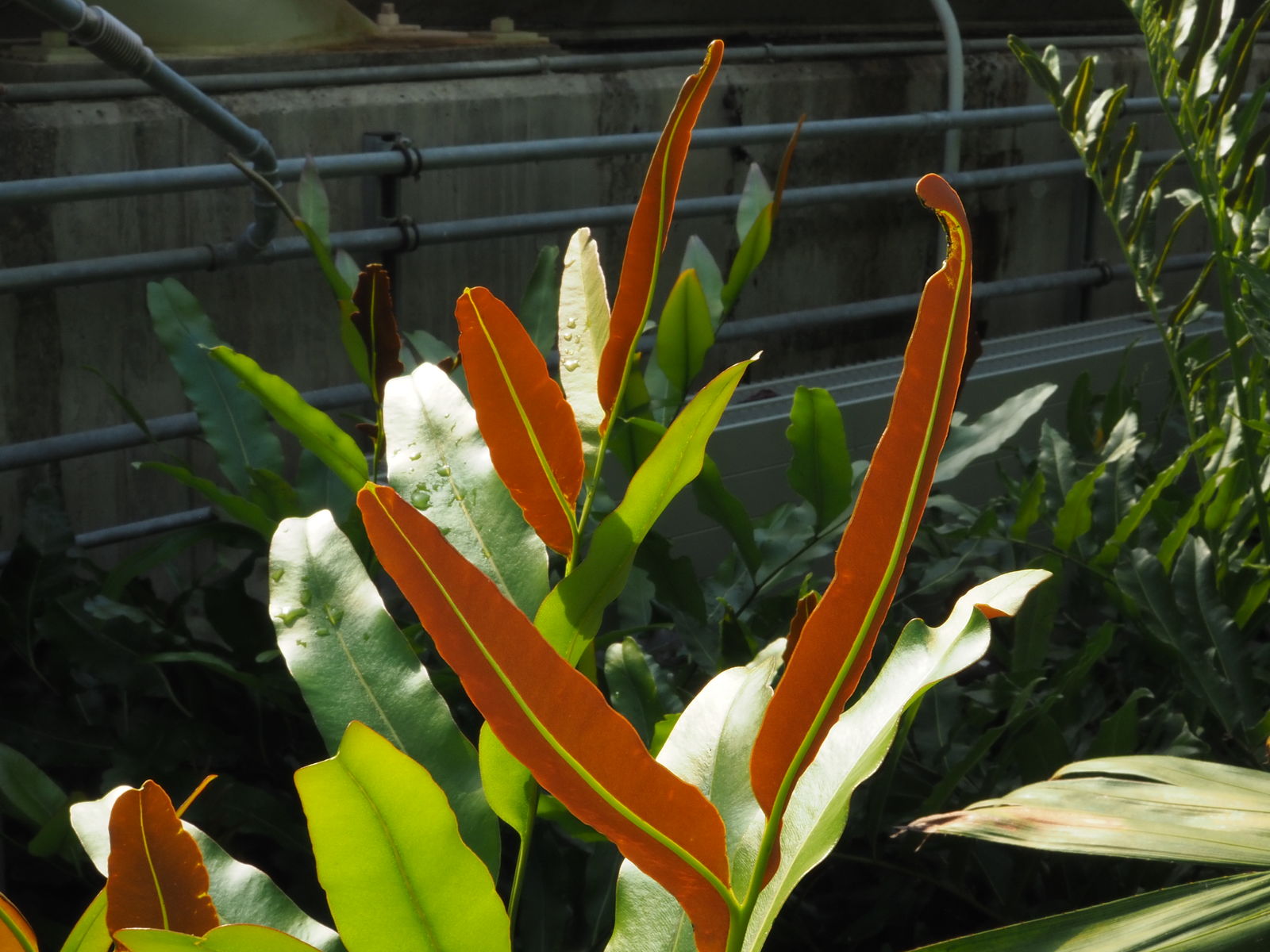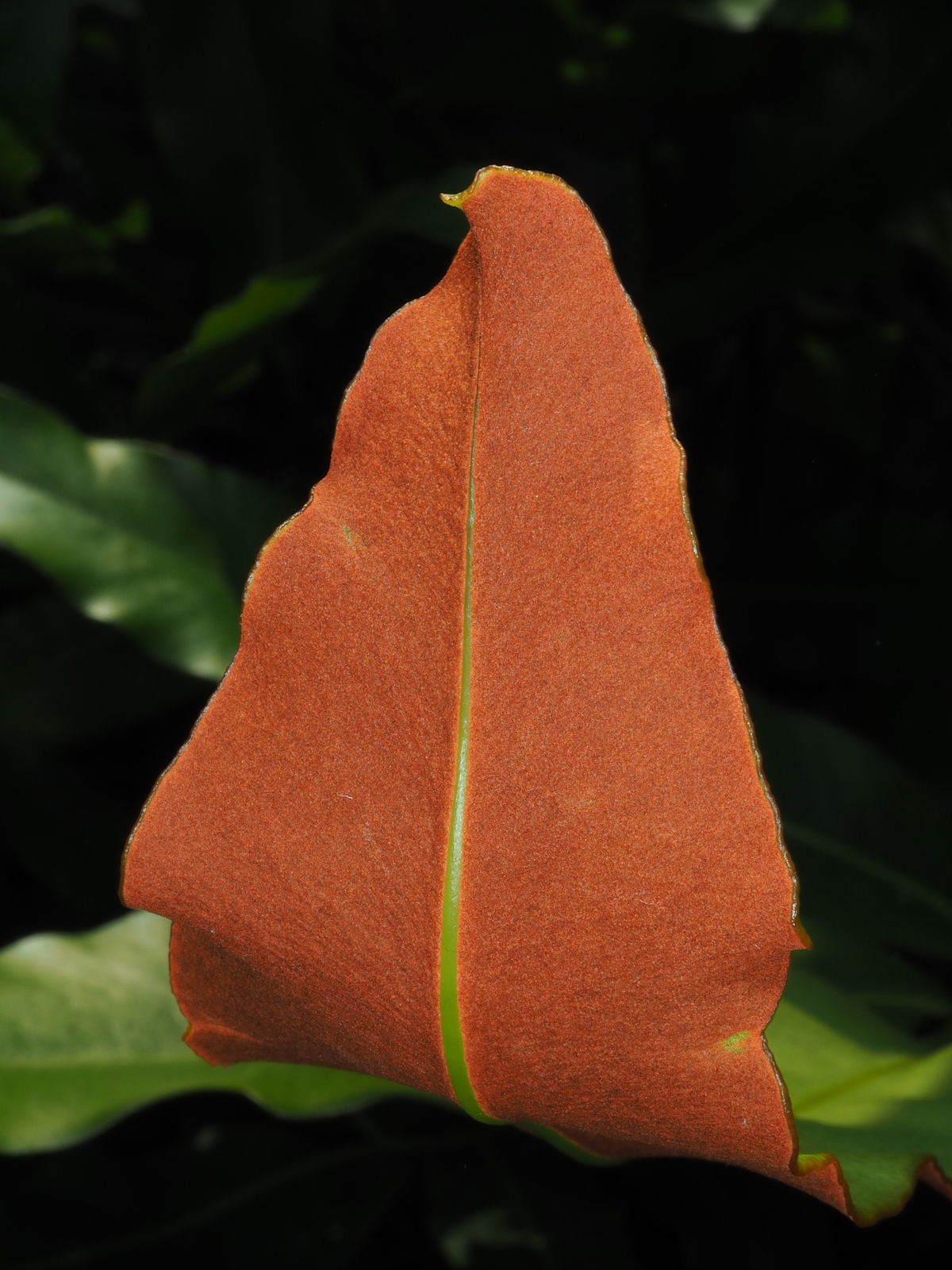Golden Leather Fern
acrostichum aureum
Also known as: ["Golden Leather Fern","Golden Leather Fern"]
Overview
A large, evergreen fern with leathery, golden-yellow fronds, typically found in mangrove swamps and coastal areas.
Benefits & Perks
["shade tolerant","wildlife attractant (bees, butterflies, birds)","drought tolerant"]
Botanical Classification
| Phylum: | Tracheophyta |
| Class: | Polypodiopsida |
| Order: | Pteridales |
| Family: | Pteridaceae |
| Genus: | Acrostichum |
| Botanical Name: | Acrostichum aureum |
Plant Characteristics
Basic Information
- Category: Leaf Plants
- Suitable Location: tropical or subtropical garden, near water bodies
- Suitable For:
- Is Weed: No
- Allergenicity: low
Environmental Needs
- Climate: {"temperatureRange":"20–35°C"}
- Hardiness: {"zones":"9–11"}
- Misting: every 2–3 days to maintain high humidity
- Drainage: Well-draining to prevent waterlogging.
- Soil Type: Rich, well-draining potting mix with organic matter like peat or compost.
Maintenance Level
- Maintenance Level: moderate
- Toughness Level: high
- Pruning Frequency: As needed, typically every few months or after flowering if applicable.
- Pruning Intensity: Light to moderate; avoid removing more than one-third of the plant at a time.
Care Details
Ideal Sunlight Coverage:
Bright indirect light for 6–8 hours daily; tolerates partial shade, especially in hot climates.
Sunlight Tolerance Tips:
Acclimate gradually to intense light; protect from direct midday sun to prevent scorching; adjust placement based on indoor/outdoor conditions.
Care Requirements
Care Difficulty
moderatemoderate
Sunlight
partial shade to full shade
Rotate plant for even growth; use sheer curtains to filter intense light; avoid sudden light changes.
Watering
every 7–10 days during active growth, reduce in winter
Water thoroughly until it drains from the bottom; allow soil to dry slightly between waterings; avoid waterlogging.
Soil
moist, rich, organic soil with good drainage
pH: Slightly acidic to neutral (pH 5.5–7.0).
Use a mix with good drainage; avoid heavy clay soils; top-dress with compost annually.
Temperature
Prefers warm temperatures (65–85°F); thrives in humid environments; avoid exposure to temperatures below 50°F.
Monitor room temperature; use a humidifier in dry climates; protect from drafts.
Fertilizing
every 2 months during growing season
Avoid over-fertilizing to prevent salt buildup; flush soil occasionally to remove excess salts; apply fertilizer to moist soil to prevent root burn.
Propagation
Methods
Stem cuttings or division of rhizomes.
Step-by-Step Propagation Guide
- Select healthy stem or rhizome.
- Cut below a node for cuttings.
- Plant in moist medium.
- Keep warm and humid.
Best Time: Spring or early summer when the plant is actively growing.
Environment
Warm, humid environment with indirect light; maintain consistent moisture.
Medium
Well-draining potting mix with perlite or sand for cuttings; moist sphagnum moss for rhizome division.
Hormone
Rooting hormone can be used but is not strictly necessary for rhizome division.
Timeline
Roots may develop in 4–6 weeks for cuttings; rhizome divisions establish faster if healthy.
Tools Needed
Sharp scissors or knife, rooting hormone (optional), small pots, moist medium.
Quick Tips
Keep cuttings out of direct sun; maintain high humidity with a plastic bag; ensure medium stays moist but not waterlogged.
Pruning & Repotting
Pruning Guide
Method
Cut fronds at the base using clean, sharp tools; avoid tearing to prevent damage or disease.
Pruning Plan
Remove dead or damaged fronds to maintain appearance and health; thin out overcrowded growth to improve air circulation.
Tools
Pruning shears, sharp knife, or scissors.
Checklist
Sanitize tools; cut cleanly at the base; remove only dead/damaged growth; dispose of clippings properly.
Repotting Guide
Best Season
Spring, before the active growing season begins.
Pot Size
Choose a pot one size larger (1–2 inches wider) than the current one.
Method
Remove plant gently; trim any dead roots; place in a new pot with fresh soil; water lightly after repotting.
Suggestions
Repot every 2–3 years or when roots fill the pot; beneficial for growth and health.
Checklist
Prepare new pot with drainage; gently remove plant; trim roots if needed; add fresh soil; water lightly.
Advanced Care Tips
Watering Mastery
Watering Checklist
Check soil moisture; water thoroughly; ensure drainage; adjust for season.
How to Apply Water Properly
Water directly at the root zone, ensuring even moisture distribution; water early in the morning to reduce evaporation; ensure excess water drains away to prevent fungal growth.
Watering Schedule Tips
Water deeply once the top inch of soil feels dry; reduce frequency in winter to prevent root rot.
Soil Improvement
Add perlite or sand for drainage; incorporate compost for fertility; ensure aeration with loose soil structure.
Temperature Stress Management
Signs of Temperature Issues
Yellowing leaves, stunted growth, or leaf drop in cold; wilting or brown leaf tips in excessive heat.
Cold Stress
Slows growth, causes leaf discoloration, and may lead to root damage in prolonged cold.
Solution: Move to a warmer location; provide a heat source if needed; avoid cold drafts.
Hot Stress
Leaves may wilt, curl, or develop brown edges; growth may slow due to excessive transpiration.
Solution: Increase humidity with misting or a humidifier; provide shade during peak heat; ensure adequate water.
Fertilizing Guide
Fertilizing Checklist
Check season; dilute fertilizer; apply to moist soil; avoid contact with leaves.
Fertilizing Method
Use a balanced liquid fertilizer diluted to half strength every 4–6 weeks during growing season (spring/summer); reduce or stop in fall/winter.
Common Problems & Solutions
Toxicity Warning
Cats
Slightly ToxicCats may experience mild gastrointestinal irritation if they ingest parts of Acrostichum aureum. The plant is not considered highly toxic to felines but can cause mild symptoms.
⚠️ Symptoms:
🌿 Toxic Parts:
⚡ Toxic If:
if eaten
Dogs
Slightly ToxicIn dogs, ingestion of Acrostichum aureum fronds can lead to mild gastrointestinal upset. The plant is not highly toxic but can cause discomfort if consumed in significant quantities.
⚠️ Symptoms:
🌿 Toxic Parts:
⚡ Toxic If:
if eaten
Humans
Slightly ToxicAcrostichum aureum contains compounds that can cause mild gastrointestinal distress upon ingestion. The fronds may irritate the digestive tract, leading to discomfort but typically not severe poisoning.
⚠️ Symptoms:
🌿 Toxic Parts:
⚡ Toxic If:
if eaten
Frequently Asked Questions
Q: Is Acrostichum aureum toxic to pets?
A: No, it is non-toxic to dogs and cats.
Q: Where is Acrostichum aureum commonly found?
A: It is typically found in mangrove swamps and coastal areas.
Q: What are the care requirements for Acrostichum aureum?
A: It requires moderate care, is drought tolerant, and prefers shaded areas.
Quick Reference
| Family: | Pteridaceae |
| Care: | moderate |
| Light: | partial shade to full shade |
| Water: | every 7–10 days during activ |
Get Expert Care Tips
Download the Plantious app for personalized care reminders and plant identification!
Google Play App Store







